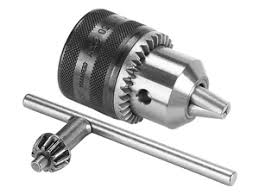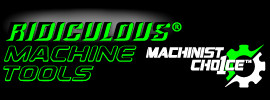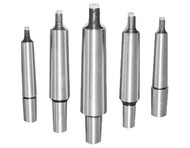Drill Chuck Arbor Explained: Types, Functions, and Applications
Posted by SRMT on May 7th 2024
Have you ever been in such a situation when it seems like all your tools are against you? Your drill keeps wobbling when you need it to be steady, and the chuck won't tighten as you desire it to. Let's jump into the seldomly discussed topic of drill chuck arbors, the real stars behind precise drilling.
For those not familiar with it, the detachable parts on power tools that hold drill bits are the drill chucks. How, then, does the chuck connect strongly with the drill? Let us look at the drill chuck arbor, which, surprisingly, is an essential component.

Unveiling the Anatomy of a Drill Chuck Arbor
Imagine a double-ended steel shaft. One end is meticulously machined to fit snugly into the spindle of your drill press or power tool. The other end is designed to connect with the back of your drill chuck seamlessly. This creates a secure connection, ensuring the drill bit remains centred and wobble-free during operation.
Types of Drill Chuck Arbors: Finding the Perfect Fit
Drill chuck arbors come in various types, each with its connection method and compatibility:
- Tapered Arbors: This is the most available type of drill bit among Rotary drill bits, and it allows a conical shank to be inserted into a taper of the spindle of a drill press or power drill. They are available in various dimensions, with the most common denominations being JT (Jacobs Taper), B taper and R8 taper.
- Threaded Arbors: The arbors have a hexagonal head that is turned on the spindle of the drill press or a power tool drill. They ensure a safe connection, but they do not provide variants of too many sizes as opposed to caterpillars.
- Integral Arbors: Certain drill chucks have an integrated arbor design. The arbor is built into the chuck itself, eliminating the need for a separate component. This offers a compact and lightweight option, but it limits interchangeability with other chucks.
- Straight Shank Arbors: The shank of these arbors is straight and cylindrical, so a set screw or locking mechanism can be utilized to secure them in the drill press spindle. They are not as widespread but are offered as an option for some drill presses.
- Jacobs Taper (JT) Arbors: The Morse taper is a widely adopted and standardized design of arbors. Cones JT exists in multiple sizes, all indicated by JT and a number (e.g., JT0, JT6, JT33): the more significant the amount, the bigger the hole capacity.
The Vital Functions of a Drill Chuck Arbor
The drill chuck arbor serves several critical functions:
- Power Transmission: It transfers rotational power from the drill press or power drill spindle to the drill chuck and thereby to a bit.
- Chuck Retention: Averting against bit slippage, the arbor that securely fits into the chuck holds the chuck tight during drilling operations.
- Concentricity: The precise machining of the arbor guarantees that the drill bit rotates perfectly centred, leading to accurate drilling.
Applications: Where Do Drill Chuck Arbors Come into Play?
Drill chuck arbors play an essential role in various drilling applications:
- Woodworking: They enable precise drilling of holes in wood for furniture construction, cabinetry, and other woodworking projects.
- Metalworking: Arbors facilitate drilling holes in metal sheets, plates, and pipes for various metal fabrication tasks.
- Construction: They are vital for drilling holes in concrete, brick, and other masonry materials for construction projects.
- DIY Projects: From hanging shelves to assembling furniture, drill chuck arbors are essential for countless household drilling tasks.
Choosing the Right Drill Chuck Arbor: Ensuring Compatibility and Performance
Here are some key factors to consider when selecting a drill chuck arbor:
- Compatibility: Make sure the arbor size and type (taper, thread, and insert) are compatible with your drill press spindle or drilling chuck of your power drill.
- Material and Durability: Go for rust-free, good-quality steel arbors that will resist the environment and last longer.
- Shank Diameter: The shank of the arbor should be the same thickness as the drill bits you will use so as not to impede the cutting process.
- Brand and Reputation: Pay extra attention to arbors, especially when buying them from established brands, such as Ridiculous Tools Machine, which are well recognized for their quality as well as production standards.
Maintaining Your Drill Chuck Arbor: Ensuring Smooth Operations
Taking care of your drill chuck arbor is crucial for optimal performance and longevity:
- Cleaning: Once in a while, clean the arbor and the chuck taper of any accumulated dust and debris that can give the shank an unsteady grip.
- Lubrication: Put a layer of bearing fluid on the face of the latches to prevent them from jamming and stripping.
- Inspection: The supervision of the arbor should be done on a regular basis, and indicators of wear or damage, such as cracks or bends, should be looked for. Change the damaged arbor, as it may decrease drilling performance and cause safety issues.
Drill chuck arbors are essential to the safety and efficiency of drilling; therefore, familiarizing yourself with these components will enable you to have a successful drilling experience. For a more comprehensive selection of drill chuck arbors and other industrial tools, explore the extensive range offered by Ridiculous Machine Tools.
It doesn't matter if you are a pro or a DIY person; the correct arbor should be one of your primary concerns.


